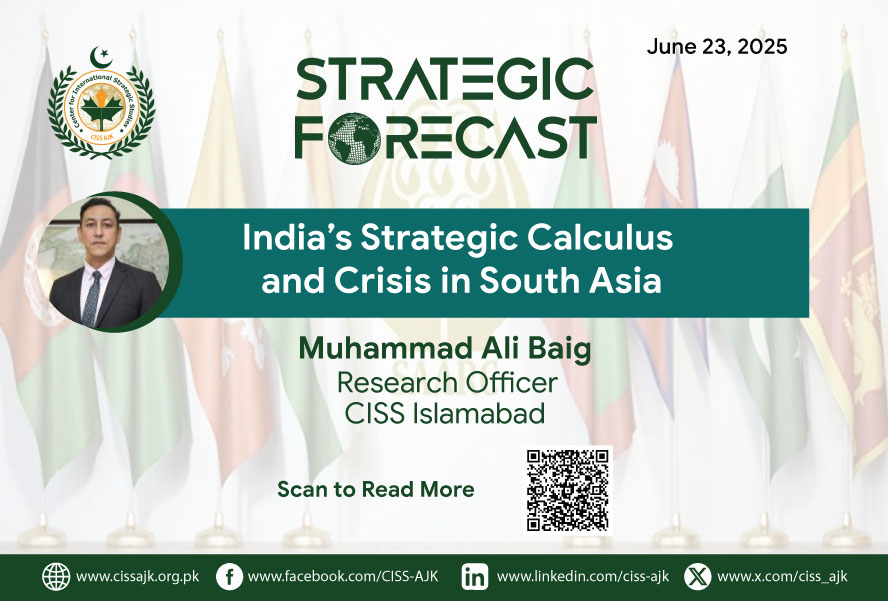On Saturday May 10, a ceasefire was declared between India and Pakistan. This followed Indian Brahmos missile strikes on various locations inside Pakistan and drone attacks which resulted in the Pakistani military’s response. The Indian attacks – which began on May 7 – caused the deaths of innocent civilians, including women, children, and the elderly. This crisis was not only related to these two nuclear power states in the region, but the whole South Asian region was rendered unstable. Regional stability now hinges on how Pakistan and India defuse the crisis and how other states respond to India’s assertive posture.
On May 7, 2025, India attacked Pakistan before dawn, using its conventional air power, and brazenly violating Pakistan’s sovereignty. The Indian Air Force struck multiple locations of Pakistan including cities in the province of Punjab and Azad Kashmir. These attacks killed innocent civilians across the cities including women and children. This was India’s response to an unproven accusation regarding the April 22 Pahalgam terrorist attack in which 28 tourists were killed. Pakistan had offered cooperation to India and called for a transparent and neutral investigation by international investigators, but India did not acknowledge. A renewed escalation between India and Pakistan over Kashmir, apart from exacerbating the bilateral equation, would place non-nuclear South Asian states i.e. Bangladesh, Sri Lanka, Nepal, Bhutan, and the Maldives under growing strategic pressure.
Bangladesh faces the greatest exposure. The recent transition to an interim government has created a politically volatile environment. This situation follows the ousting of Sheikh Hasina’s pro-India administration. Anti-India sentiment has risen in Bangladesh. It is intensified by Indian interference in its decision to host the former Prime Minister of Bangladesh. The interim leadership must respond to domestic calls with more assertive policies against Indian interference in their politics and other foreign and domestic policies. It places Dhaka in a deeply uncertain position due to Indian aggression in the region.
In Sri Lanka, the government is expected to stay neutral in public. However, it may quietly support Indian security concerns due to Indian hegemonic behavior and a rising economy. As India breached the sovereignty and territorial integrity of nuclear Pakistan and pursued aggression, it may not hesitate to pressure smaller neighbors. Pakistan defended successfully, but there is a need to address the situation for the longer term. If the Kashmir conflict is seen as part of wider repression of Muslims, it could spark unrest among Sri Lanka’s Muslim community. This could destabilize the country which is already facing economic problems. Nepal’s balancing relationship between India and China will become harder. It may try to remain neutral. However, recent border disputes and efforts by Kathmandu to assert more independence have cut ties with India. India may see Nepal’s neutrality as a lack of support. Nepal also depends on the Indian economy and has many workers living there. Bhutan will likely stay quietly aligned with India.
In the Maldives, a Kashmir flashpoint could trigger rising Muslim Brotherhood sentiment. Although there is no official stance from the Maldives on the Kashmir issue – it is a Muslim-majority Island nation – and rising public sympathy for the people of Kashmir cannot be overlooked. The current government came to power with the slogan of ‘India Out from the Maldives.’ The Indian militarization of the Indian Ocean in response would constrain Malé’s hedging strategy which would reduce its space to maneuver between the regional powers. Cumulatively, these pressures would harden regional fault lines which will limit policy autonomy and raise the domestic political costs of neutrality to South Asia’s smaller states. India’s recent military actions against Pakistan are not unnoticed by the world. Such operations show India’s broader regional ambitions and its willingness to assert dominance if it even at the risk of civilian casualties.
For the United States, this evolving dynamic poses challenges to its Indo-Pacific strategy. As a regional balancing and a key member of the Quad, India’s ability to serve as a net security provider has failed. It would be significantly diminished by protracted confrontation with Pakistan as a result of Indian military and political aggression against Pakistan. Also, it will divert Indian attention from maritime priorities and complicate Washington’s strategic calculus in the broader Indo-Pacific region.
All of these South Asian states remain on the affected side of the equation against India. Between the two nuclear-armed states, the current act of aggression by India marks a dangerous breach of regional deterrence, where the line between security and provocation has grown dangerously thin. As a nuclear-armed state, India’s act of aggression against another nuclear-armed state risks pushing the region towards an open conflict which could escalate to total war. For Pakistan, defending its sovereignty is an existential imperative. Yet the human cost which is lost – borne most heavily by innocent civilians – raises urgent moral questions vis-à-vis Indian regional hegemony under the guise of Hindutva ideology. In Kashmir, where generations have lived under occupation and the shadow of denied freedom by India, the language of justice is now being shaped by fighter jets, drones and funerals. When state-of-the-art weapons are used not to prevent war but to punish, we must ask: is this deterrence by punishment – or a form of state terrorism as another name? At the end, even if these member states of South Asia seem small in comparison to India yet their unity holds the potential to counter India’s illusion of singular supremacy. While negotiations between Indian and Pakistan continue, the region is still between escalation and peace.
Author
Muhammad Ali Baig is a researcher at the Center for International Strategic Studies (CISS), Islamabad. X@alibaig111

